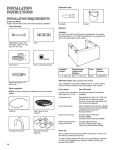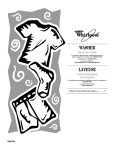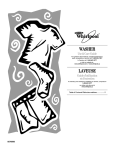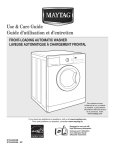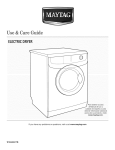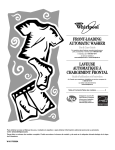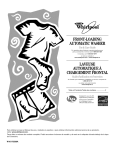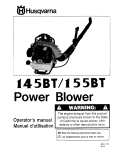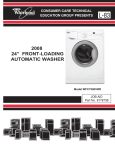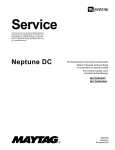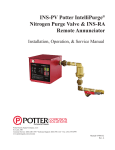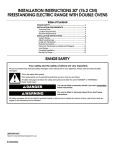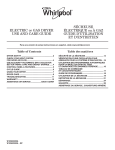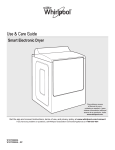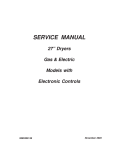Download Maytag MED7500YW Use and Care Manual
Transcript
Use & Care Guide ELECTRIC DRYER Para obtener acceso al Manual de uso y cuidado en español, o para obtener información adicional acerca de su producto, visite: www.maytag.com. If you have any problems or questions, visit us at www.maytag.com W10445417C ELECTRIC DRYER TABLE OF CONTENTS DRYER SAFETY.............................................................2 OPERATING INSTRUCTIONS.......................................4 CONTROL PANEL AND FEATURES...................................4 CYCLE GUIDE....................................................................5 USING YOUR DRYER........................................................6 DRYER CARE.....................................................................7 INSTALLATION INSTRUCTIONS...................................9 INSTALLATION REQUIREMENTS......................................9 LOCATION REQUIREMENTS...........................................10 ELECTRICAL REQUIREMENTS.......................................12 ELECTRIC INSTALLATION...............................................13 VENTING..........................................................................18 CONNECT VENT..............................................................20 LEVEL DRYER..................................................................21 TROUBLESHOOTING..................................................22 WARRANTY..................................................................27 ASSISTANCE OR SERVICE......................... Back Cover DRYER SAFETY 2 3 OPERATING INSTRUCTIONS CONTROL PANEL AND FEATURES 4 1 2 3 5 1 START BUTTON 3 POWER BUTTON 2 TEMPERATURE BUTTON 4 CYCLE CONTROL KNOB 5 POWER INDICATOR Press to start a cycle. Indicator light will glow to indicate the cycle has started. The Temperature Control button lets you choose between a normal and low drying temperature. NOTE: Always refer to the care label on the garment to determine whether it can be tumble dried. Normal The Normal temperature setting is for sturdy fabrics, such as cotton, linen, and denim. If the Temperature Control button is not pressed in, the temperature setting is Normal. Low The Low setting is for synthetics, such as cotton/polyester blend, rayon, acetate, washable silk, or nylon. If the Temperature Control button is pressed in, the temperature setting is Low. 4 Press to turn the dryer on and off. Indicator light will flash to indicate the power is on. Use your dryer’s Cycle Control knob to select available cycles on your dryer. Turn the knob to select a cycle for your laundry load. Indicator light will flash to indicate a cycle has been selected. See “Cycle Guide” for detailed descriptions of cycles. This light flashes when the power is on and glows when a cycle is running. END OF CYCLE SIGNAL The dryer sounds a signal to let you know when the cycle is complete. The signal is not adjustable and cannot be turned off. The signal is helpful when you are drying permanent press, synthetics, and other items that should be removed promptly at the end of the cycle. CYCLE GUIDE — SENSOR DRY CYCLES Use Sensor Dry Cycles for better fabric care and energy savings When you are using the GentleBreeze™ Drying System with IntelliDry® Sensor, two metal strips located on the dryer determine the dryness of the load. When there is moisture left in the clothes, the dryer will continue to run. As clothes begin to dry, the amount of water left in the clothes decreases, and the timer advances through the remainder of the cycle. When the selected dryness level is reached, the dryer goes into a cool-down period of up to 15 minutes. Sensor dry cycles may be used for most loads. Sensor dry cycles give the best drying results in the shortest time. Drying time varies according to the type of fabric, size of the load, and dryness setting. After drying a load, check the dryness. n If the load is drier than you like, select a setting closer to Iron Dry the next time you dry a similar load. n If a load is not as dry as you like, complete drying using a Timed cycle. Select a setting closer to More Dry the next time you dry a similar load. Items to dry: Cycle: Temperature Setting: More Dry Normal Normal Normal Normal Low Regular Heavy cottons and denims Cottons and linens Synthetics White and colorfast permanent press White and colorfast items that require ironing Iron Dry Low Polyester/acrylic blends, rayon, acetate Damp Dry Low Washable silk and nylon Damp Dry Low CYCLE GUIDE — TIMED DRY CYCLES Use this cycle to get up to 60 minutes of heated drying time or to complete drying if items are still damp after the automatic cycle. Timed Dry is also useful for: n Heavyweight items and work clothes that require a long drying time. n Lightweight items, such as lingerie, blouses, and knits that require a short drying time. Items to dry: Time (Minutes): Temperature Setting: Heavy cottons and denims 60Normal Cottons and linens 40 Normal White and colorfast permanent press 40 Low White and colorfast items that require ironing 40 Low Polyester/acrylic blends, rayon, acetate 40 Low Washable silk and nylon 40 Low 5 USING YOUR DRYER WARNING: To reduce the risk of fire, electric shock, or injury to persons, read the IMPORTANT SAFETY INSTRUCTIONS before operating this appliance. 1. Clean the lint screen 3. Press POWER Press the POWER button to turn on the dryer. The indicator light will flash to indicate that the power is on. Clean the lint screen before each load. Pull the lint screen straight up. Open lint screen. Roll lint off the screen with your fingers. Do not rinse or wash screen to remove lint. Wet lint is hard to remove. Close lint screen. Push the lint screen firmly back into place. For additional cleaning information, see “Dryer Care.” 2. Load the dryer Open the door by pulling on the handle. Place laundry in the dryer. Add a static reducing sheet to wet load, if desired. Close the door. IMPORTANT: Do not tightly pack the dryer. Items need to tumble freely. Tightly packing the load can lead to poor drying performance and may increase wrinkling and tangling. 6 4. Press TEMPERATURE Press the TEMPERATURE button to select the recommended temperature setting for the type of load being dried. 5. Select the desired cycle DRYER CARE CLEANING THE DRYER LOCATION Keep dryer area clear and free from items that would block the air flow for proper dryer operation. This includes clearing piles of laundry in front of the dryer. Select the desired cycle for your load. See the “Cycle Guide” for more information about each cycle. NOTE: Most loads may be dried using the Normal dryness level, which is shown in bold letters on the control panel. Normal is the energy preferred dryness level and will use the least energy. 6. P ress START to begin cycle CLEANING THE DRYER INTERIOR Press and hold the START button to begin the cycle. To stop your dryer at any time: Turn the Cycle Control knob to the STOP position or open the door. To restart the dryer: 1. Close the door. 2. Select a new cycle and temperature (if desired). 3. After the beep sounds, press the START button. To change the cycle or temperature after pressing START: 1. Open the dryer door. 2. Press the TEMPERATURE button to change the temperature (if desired). 3. Turn the cycle knob to the new desired position. 4. After the beep sounds, press the START button. To clean dryer drum 1. Use a mild hand dish detergent mixed at a low concentration with very warm water, and rub with a soft cloth. 2. Rinse well with a wet sponge or towel. 3. Tumble a load of clean clothes or towels to dry drum OR Use a microfiber cloth and hot water in a spray bottle to clean the drum and a second microfiber towel to dry. NOTE: Garments that contain unstable dyes, such as denim blue jeans or brightly colored cotton items, may discolor the rear of the dryer interior. These stains are not harmful to your dryer and will not stain future loads of clothes. Dry unstable dye items inside out to avoid transfer of dye. REMOVING ACCUMULATED LINT From Inside the Dryer Cabinet Lint should be removed every 2 years, or more often, depending on dryer usage. Cleaning should be done by a qualified appliance servicer or ventilation system cleaner. From the Exhaust Vent Lint should be removed every 2 years, or more often, depending on dryer usage. 7 CLEANING THE LINT SCREEN Every load cleaning The lint screen is located in the door opening of the dryer. The control panel has an indicator light to remind you to clean the lint screen before each load. A screen blocked by lint can increase drying time. To clean: 1. Pull the lint screen straight up. Open lint screen. Roll lint off the screen with your fingers. Do not rinse or wash screen to remove lint. Wet lint is hard to remove. VACATION, STORAGE, AND MOVING CARE Install and store your dryer where it will not freeze. Because some water may stay in the hoses, freezing can damage your dryer. If storing or moving your dryer during freezing weather, winterize it. Non-Use or Storage Care Operate your dryer only when you are at home. If you will be on vacation or not using your dryer for an extended period of time, you should: 1. Unplug dryer or disconnect power. 2. Clean lint screen. See “Cleaning the Lint Screen.” Moving Care For power supply cord-connected dryers: 1. Unplug the power supply cord. 2. Make sure leveling legs are secure in dryer base. 3. Use masking tape to secure dryer door. 2.Close lint screen. Push the lint screen firmly back into place. IMPORTANT: n Do not run the dryer with the lint screen loose, damaged, blocked, or missing. Doing so can cause overheating and damage to both the dryer and fabrics. n If lint falls off the screen into the dryer during removal, check the exhaust hood and remove the lint. See “Venting Requirements.” As needed cleaning Laundry detergent and fabric softener residue can build up on the lint screen. This buildup can cause longer drying times for your clothes, or cause the dryer to stop before your load is completely dry. The screen is probably clogged if lint falls off while the screen is in the dryer. Clean the lint screen with a nylon brush every 6 months, or more frequently, if it becomes clogged due to a residue buildup. To wash: 1. Roll lint off the screen with your fingers. 2. Wet both sides of lint screen with hot water. 3. Wet a nylon brush with hot water and liquid detergent. Scrub lint screen with the brush to remove residue buildup. 4. Rinse screen with hot water. 5. Thoroughly dry lint screen with a clean towel. Reinstall screen in dryer. 8 For direct-wired dryers: 1. Disconnect power. 2. Disconnect wiring. 3. Make sure leveling legs are secure in dryer base. 4. Use tape to secure dryer door. Reinstalling the Dryer Follow the “Installation Instructions” to locate, level, and connect the dryer. INSTALLATION INSTRUCTIONS INSTALLATION REQUIREMENTS TOOLS AND PARTS Parts needed: (Not supplied with dryer) Gather the required tools and parts before starting installation. Vent clamps Vent elbows and ductwork Additional parts may be required, depending on your installation. Check local codes. Check existing electrical supply and venting. Read “Electrical Requirements” and “Venting Requirements” before purchasing parts. Tools needed: If using a power supply cord: Flat-blade screwdriver Wood block Use a UL listed power supply cord kit marked for use with clothes dryers. The kit should contain: n A UL listed 30-amp power supply cord, rated 120/240 volt minimum. The cord should be type SRD or SRDT and be at least 4 ft. (1.22 m) long. The wires that connect to the dryer must end in ring terminals or spade terminals with upturned ends. n A UL listed strain relief. Parts supplied: Wire stripper (direct wire installations) Tin snips (new vent installations) Parts package is located in dryer drum. Check that all parts are included. NOTE: Do not use leveling legs supplied if installing with a pedestal or a stack kit. 1/4" (7 mm) nut driver (recommended) Adjustable wrench that opens to 1" (25 mm) or hex-head socket wrench Coupling Level Caulking gun and compound (for installing new exhaust vent) Torx® T20 screwdriver Options: (Not supplied with dryer) Pedestal You may order a pedestal separately for this dryer. This pedestal will add about 12" (305 mm) to the height of your unit for a total height of approximately 45" (1.14 m). To order, call the dealer from whom you purchased your dryer or refer to the “Assistance or Service” section of this manual. Ask for Model Number LAB0050PQ. Stack kit Are you planning to stack your washer and dryer? Your dryer is shipped with Stack Kit W10178021, which fits Maytag® washer models starting with MHWC. If you have any other washer model, call the dealer from whom you purchased your dryer or refer to the “Assistance or Service” section of this manual. ® TORX is a registered trademark of Saturn Fasteners, Inc. 9 LOCATION REQUIREMENTS DRYER DIMENSIONS Check code requirements. Some codes limit, or do not permit, installing dryer in garages, closets, mobile homes, or sleeping quarters. Contact your local building inspector. Front view: 233/8" (594 mm) 331/4" (845 mm) You will need: nA location allowing for proper exhaust installation. See “Venting Requirements.” nA separate 30 amp circuit. nIf using power supply cord, a grounded electrical outlet located within 2 ft. (610 mm) of either side of dryer. See “Electrical Requirements.” nFloor must support dryer weight of 115 lbs. (52 kg). Also consider weight of companion appliance. nLevel floor with maximum slope of 1" (25 mm) under entire dryer. If slope is greater than 1" (25 mm), install Extended Dryer Feet Kit, Part Number 279810. If not level, clothes may not tumble properly and automatic sensor cycles may not operate correctly. nFor garage installation, place dryer at least 18" (460 mm) above floor. If using a pedestal, you will need 18" (460 mm) to bottom of dryer. nThe dryer must not be installed or stored in an area where it will be exposed to water and/or weather. IMPORTANT: Do not operate, install, or store dryer where it will be exposed to water, weather, or at temperatures below 45° F (7° C). Lower temperatures may cause dryer not to shut off at end of sensor cycles, resulting in longer drying times. Installation Clearances For each arrangement, consider allowing more space for ease of installation and servicing, spacing for companion appliances, and clearances for walls, doors, and floor moldings. Space must be large enough to allow door to fully open. Add spacing on all sides of dryer to reduce noise transfer. If a closet door or louvered door is installed, top and bottom air openings in door are required. Check code requirements. Some codes limit, or do not permit, installation of the dryer in garages, closets, mobile homes, or sleeping quarters. Contact your local building inspector. Side view: 39" (991 mm) 231/4" (603 mm) Back view: NOTE: Most installations require a minimum of 5" (127 mm) clearance behind dryer for exhaust vent with elbow. See “Venting Requirements.” 31/4" (83 mm) Power supply cord/cable 27" (686 mm) Vent 113/4" (299 mm) 10 Installation spacing for recessed area or closet installation Recessed or closet installation – Stacked with stack kit: nAll dimensions show recommended and minimum spacing allowed. nAdditional spacing should be considered for ease of installation and servicing. nAdditional clearances might be required for wall, door, floor moldings, and dryer venting. nAdditional spacing should be considered on all sides of the dryer to reduce noise transfer. nFor closet installation with a door, minimum ventilation openings in the top and bottom of the door are required. Louvered doors with equivalent ventilation openings are acceptable. n Companion appliance spacing should also be considered. Custom undercounter installation (dryer only): 331/4" (845 mm) 12" (305 mm) 3" (76 mm) 48 in.2 (310 cm2) 653/4" (1670 mm) 5/" (133 mm) 1 4 3" (76 mm) 1" (25 mm) 24 in.2 (155 cm2) 1" (25 mm) Mobile home - Additional installation requirements: This dryer is suitable for mobile home installations. The installation must conform to the Manufactured Home Construction and Safety Standard, Title 24 CFR, Part 3280 (formerly the Federal Standard for Mobile home construction and Safety, Title 24, HUD Part 280). 1" (25 mm) 1" (25 mm) Mobile home installations require: Recessed or closet installation (dryer only): 18"9" min (457 (229 mm) mm) 3" (76 mm) 3" (76 mm) 3" (76 mm) 1" (25 mm) nMetal exhaust system hardware, available for purchase from your dealer. nSpecial provisions must be made in mobile homes to introduce outside air into dryer. Openings (such as a nearby window) should be at least twice as large as dryer exhaust opening. 48 in.2 (310 cm2) 24 in.2 (155 cm2) 1" (25 mm) 11 ELECTRICAL REQUIREMENTS It is your responsibility: nTo contact a qualified electrical installer. nTo be sure that the electrical connection is adequate and in conformance with the National Electrical Code, ANSI/NFPA 70 – latest edition and all local codes and ordinances. The National Electrical Code requires a 4-wire power supply connection for homes built after 1996, dryer circuits involved in remodeling after 1996, and all mobile home installations. A copy of the above code standards can be obtained from: National Fire Protection Association, One Batterymarch Park, Quincy, MA 02269. nTo supply the required 3 or 4 wire, single phase, 120/240 volt, 60 Hz, AC only electrical supply (or 3 or 4 wire, 120/208 volt electrical supply, if specified on the serial/rating plate) on a separate 30-amp circuit, fused on both sides of the line. Connect to an individual branch circuit. Do not have a fuse in the neutral or grounding circuit. nDo not use an extension cord. nIf codes permit and a separate ground wire is used, it is recommended that a qualified electrician determine that the ground path is adequate. Electrical Connection To properly install your dryer, you must determine the type of electrical connection you will be using and follow the instructions in “Electric Installation.” nThis dryer is manufactured ready to install with a 3-wire electrical supply connection. The neutral ground conductor is permanently connected to the neutral conductor (white wire) within the dryer. If the dryer is installed with a 4-wire electrical supply connection, see “4-Wire Direct Wire Connection.” nA 4-wire power supply connection must be used when the appliance is installed in a location where grounding through the neutral conductor is prohibited. Grounding through the neutral is prohibited for (1) new branch-circuit installations after 1996, (2) mobile homes, (3) recreational vehicles, and (4) areas where local codes prohibit grounding through the neutral conductors. If using a power supply cord: Use a UL listed power supply cord kit marked for use with clothes dryers. The kit should contain: nA UL listed 30-amp power supply cord, rated 120/240 volt minimum. The cord should be type SRD or SRDT and be at least 4 ft. (1.22 m) long. The wires that connect to the dryer must end in ring terminals or spade terminals with upturned ends. nA UL listed strain relief. 12 If your outlet looks like this: Then choose a 4-wire power supply cord with ring or spade terminals and UL listed strain relief. The 4-wire power supply cord, at least 4 ft. (1.22 m) long, must have four 10-gauge copper wires and match a 4-wire receptacle of NEMA Type 14-30R. The ground wire (ground 4-wire receptacle conductor) may be either green or bare. The (14-30R) neutral conductor must be identified by a white cover. If your outlet looks like this: 3-wire receptacle (10-30R) Then choose a 3-wire power supply cord with ring or spade terminals and UL listed strain relief. The 3-wire power supply cord, at least 4 ft. (1.22 m) long, must have three 10-gauge copper wires and match a 3-wire receptacle of NEMA Type 10-30R. If connecting by direct wire: Power supply cable must match power supply (4-wire or 3-wire) and be: nFlexible armored cable or nonmetallic sheathed copper cable (with ground wire), covered with flexible metallic conduit. All current-carrying wires must be insulated. n10-gauge solid copper wire (do not use aluminum) at least 5 ft. (1.52 m) long. ELECTRIC INSTALLATION For power supply cord installations: For direct wire installations: Before you start: disconnect power. 1. Choose electrical connection type 2. Remove terminal block cover Power supply cord 4-wire receptacle (NEMA Type 14-30R). Go to “Power Supply Cord Connection.” Power supply cord 3-wire receptacle (NEMA Type 10-30R). Go to “Power Supply Cord Connection.” 4-wire direct connection: Go to “Direct Wire Connection.” 3-wire direct connection: Go to “Direct Wire Connection.” Remove hold-down screw and terminal block cover. 13 Power Supply Cord Connection Power supply cord strain relief: 1. Attach power supply cord to strain relief 4-Wire Power Supply Cord Connection IMPORTANT: A 4-wire connection is required for mobile homes and where local codes do not permit the use of 3-wire connections. A 4-wire receptacle (NEMA type 14-30R) 4-prong plug Spade terminals with upturned ends Ring terminals B C Unscrew the strain relief (A) from the terminal block cover. Unscrew the strain relief nut (B) from the strain relief (A). Put the power supply cord (C) through the strain relief nut (B), then the strain relief (A). Be sure that the wire insulation on the power supply cord is inside the strain relief. 2. Replace strain relief 1. Remove neutral ground wire F A A B B C D Replace strain relief (B) (with power cord [D] inserted) back into the terminal block cover (A). Do not tighten strain relief nut (C). If your outlet looks like this: Power supply cord 4-wire receptacle (NEMA Type 14-30R): Go to “4-Wire Power Supply Cord Connection” on this page. If your outlet looks like this: Power supply cord 3-wire receptacle (NEMA Type 10-30R): Go to “3-Wire Power Supply Cord Connection” on page 15. 14 Remove the neutral ground wire (F) located inside the dryer cabinet, behind the external ground conductor screw (A). 2. Connect ground wire and neutral wire B D A E Connect ground wire (E) (green or bare) of power supply cord to external ground conductor screw (A). Tighten screw. Connect neutral wire (D) (white or center wire) of power supply cord under center screw (B) of the terminal block. 3. Connect remaining wires 1. Remove center screw B Connect the other wires to outer terminal block screws. Tighten screws. Replace the terminal block cover on the back of the dryer. Tighten strain relief nut. Now, go to “Venting Requirements.” Remove center terminal block screw (B). 2. Connect neutral wire 3-Wire Power Supply Cord Connection Use where local codes permit connecting cabinet-ground conductor to neutral wire. 3-wire receptacle (NEMA type 10-30R) 3-prong plug B D Connect neutral wire (white or center) (D) of power supply cord under center terminal block screw (B). Tighten screw. 3. Connect remaining wires Spade terminals with upturned ends Ring terminals Connect remaining wires under outer terminal block screws. Tighten screws. Finally, reinsert tab of terminal block cover into slot of dryer rear panel. Tighten strain relief nut. Now, go to “Venting Requirements.” 15 Direct Wire Connection 3. Connect power supply cable wire If your wiring looks like this: 4-wire direct connection: Go to “4-Wire Direct Connection” on this page. If your wiring looks like this: B D 3-wire direct connection: Go to “3-Wire Direct Connection” on page 17. 4-Wire Direct Wire Connection IMPORTANT: A 4-wire connection is required for mobile homes and where local codes do not permit 3-wire connections. 1. Prepare your 4-wire cable for direct connection 31 ⁄2" m) (89 m 1" m) (25 m Place the hooked end of the center white wire (D) of power supply cable under the center screw (B) of terminal block (hook facing right). Squeeze hooked end together. Tighten screw. 4. Connect remaining wires 5 (127 " mm ) Direct wire cable must have 5 ft. (1.52 m) of extra length so dryer may be moved if needed. Strip 5" (127 mm) of outer covering from end of cable, leaving bare ground wire at 5" (127 mm). Cut 11/2" (38 mm) from remaining 3 wires. Strip insulation back 1" (25 mm). Shape ends of wires into hooks. 2. Remove neutral ground wire Place hooked ends of remaining direct wire cable wires under outer terminal block screws (hooks facing right). Squeeze hooked ends together and tighten screws. Replace the terminal block cover on the back of the dryer. Tighten strain relief nut. Now, go to “Venting Requirements.” F B A Remove the neutral ground wire (white) (F) located inside the dryer cabinet, behind the external ground conductor screw (A). 16 3-Wire Direct Wire Connection Use where local codes permit connecting cabinet-ground conductor to neutral wire. 3. Connect neutral wire 1. Prepare your 3-wire cable B for direct connection D 1" m) (25 m 3½" (89 m m) Direct wire cable must have 5 ft. (1.52 m) of extra length so dryer may be moved if needed. Strip 31/2" (89 mm) of outer covering from end of cable. Strip insulation back 1" (25 mm). If using 3-wire cable with ground wire, cut bare wire even with outer covering. Shape wire ends into hooks. Place hooked end of neutral wire (white or center) (D) of direct wire cable under center terminal block screw (B), hook facing right. Squeeze hooked end together. Tighten screw. 4. Connect remaining wires 2. Remove center screw B Place hooked ends of remaining direct wire cable wires under outer terminal block screws (hooks facing right). Squeeze hooked ends together and tighten screws. Replace the terminal block cover on the back of the dryer. Tighten strain relief nut. Now, go to“ Venting Requirements.” Remove center terminal block screw (B). 17 VENTING Venting Requirements Exhaust hoods: n An exhaust hood should cap the vent to keep rodents and insects from entering the home. n Must be at least 12" (305 mm) from ground or any object that may obstruct exhaust (such as flowers, rocks, bushes, or snow). n Do not use an exhaust hood with a magnetic latch. Recommended Styles: Louvered Hood Box Hood Acceptable Style: WARNING: To reduce the risk of fire, this dryer MUST BE EXHAUSTED OUTDOORS. IMPORTANT: Observe all governing codes and ordinances. Dryer exhaust must not be connected into any gas vent, chimney, wall, ceiling, attic, crawlspace, or a concealed space of a building. Only rigid or flexible metal vent shall be used for exhausting. Angled Hood Elbows: n 45° elbows provide better airflow than 90° elbows. 4" (102 mm) Good Better 4" (102 mm) heavy metal exhaust vent n Only a 4" (102 mm) heavy metal exhaust vent and clamps may be used. n Do not use plastic or metal foil vent. Rigid metal vent: n Recommended for best drying performance and to avoid crushing and kinking. Flexible metal vent: (Acceptable only if accessible to clean) n Must be fully extended and supported in final dryer location. n Remove excess to avoid sagging and kinking that may result in reduced airflow and poor performance. n Do not install in enclosed walls, ceilings, or floors. n The total length should not exceed 73/4 ft. (2.4 m). n The length of flexible metal vent used must be included in the overall vent system design as shown in the “Vent System Chart.” NOTE: If using an existing vent system, clean lint from entire length of the system and make sure exhaust hood is not plugged with lint. Replace plastic or metal foil vents with rigid metal or flexible metal vents. Review “Vent System Chart” and, if necessary, modify existing vent system to achieve best drying performance. 18 Clamps: n Use clamps to seal all joints. n Exhaust vent must not be connected or secured with screws or other fastening devices that extend into interior of duct and catch lint. Do not use duct tape. Special provisions for mobile homes: Plan Vent System Exhaust vent must be securely fastened to a noncombustible portion of mobile home and must not terminate beneath the mobile home. Terminate exhaust vent outside. Choose your exhaust installation type Recommended exhaust installation: A B C D E F G B H A.Dryer B.Elbow C.Wall D.Exhaust hood E.Clamps F. Rigid metal or flexible metal vent G.Vent length necessary to connect elbows H.Exhaust outlet Alternate installations for close clearances: Venting systems come in many varieties. Select the type best for your installation. A close-clearance installation is shown below. Refer to the manufacturer’s instructions. Determine vent path: n Select route that will provide straightest and most direct path outdoors. n Plan installation to use fewest number of elbows and turns. n When using elbows or making turns, allow as much room as possible. n Bend vent gradually to avoid kinking. n Use as few 90° turns as possible. Determine vent length and elbows needed for best drying performance: Use the following “Vent System Chart” to determine type of vent material and hood combinations acceptable to use. NOTE: Do not use vent runs longer than those specified in “Vent System Chart.” Exhaust systems longer than those specified will: ■■ Shorten life of dryer. ■■ Reduce performance, resulting in longer drying times and increased energy usage. Over-the-top installation (also available with one offset elbow) Over-the-Top Installation Kit Part Number 4396028 for close clearance alternate installation is available for purchase. For ordering information, see “Assistance or Service.” The “Vent System Chart” provides venting requirements that will help achieve best drying performance. Vent System Chart Number of 90° elbows Type of vent Box/louvered hoods Angled hoods 0 Rigid metal 90 ft. (27.4 m) 80 ft. (24.4 m) 1 Rigid metal 80 ft. (24.4 m) 70 ft. (21.3 m) 2 Rigid metal 70 ft. (21.3 m) 60 ft. (18.3 m) 19 CONNECT VENT Install Vent System 1. Install exhaust hood 12" min. (305 mm) 1. Connect vent to exhaust outlet 12" min. (305 mm) Install exhaust hood and use caulking compound to seal exterior wall opening around exhaust hood. 2. Connect vent to exhaust hood Using a 4" (102 mm) clamp, connect vent to exhaust outlet in dryer. If connecting to existing vent, make sure vent is clean. Dryer vent must fit over dryer exhaust outlet and inside exhaust hood. Check that vent is secured to exhaust hood with a 4" (102 mm) clamp. 2. Move dryer to final location Vent must fit over the exhaust hood. Secure vent to exhaust hood with 4" (102 mm) clamp. Run vent to dryer location using straightest path possible. Avoid 90° turns. Use clamps to seal all joints. Do not use duct tape, screws, or other fastening devices that extend into interior of vent to secure vent, because they can catch lint. Move dryer to final location, taking care not to crush or kink vent. After dryer is in place, remove corner posts and cardboard from under dryer. 20 LEVEL DRYER COMPLETE INSTALLATION CHECKLIST 1. Level dryer q Check that all parts are now installed. If there is an extra part, go back through steps to see what was skipped. q Check that you have all of your tools. q Dispose of/recycle all packaging materials. q Check dryer’s final location. Be sure vent is not crushed Place level here or kinked. q Check that dryer is level. See “Level Dryer”. q Remove film on console and any tape remaining on dryer. q Wipe dryer drum interior thoroughly with a damp cloth to Check levelness of dryer from side to side. Repeat from front to back. NOTE: The dryer must be level for the moisture sensing system to operate correctly. Not Level LEVEL Not Level 2. Adjust leveling legs remove any dust. q Read “Using Your Dryer.” q For power supply cord installation, plug into a grounded outlet. For direct wire installation, turn on power. qSet the dryer on a full heat cycle (not an air cycle) for 20 minutes and start the dryer. If dryer will not start, check the following: • Controls are set in a running or “On” position. • Start button has been pushed firmly. • Dryer is plugged into an outlet and/or electrical supply. • Household fuse is intact and tight, or circuit breaker has not tripped. • Dryer door is closed. NOTE: You may notice an odor when dryer is first heated. This odor is common when heating element is first used. The odor will go away. If dryer is not level, prop up using a wood block, use wrench to adjust legs up or down, and check again for levelness. Once dryer is level, make sure all four legs are snug against the floor and dryer does not rock. 21 TROUBLESHOOTING First try the solutions suggested here or visit our website at www.maytag.com/help for assistance and to possibly avoid a service call. If you experience Solution Possible Causes Dryer Operation Door not closed completely. Make sure the dryer door is closed completely. START button not pressed firmly or held long enough. Press and hold the START button 2–5 seconds. Household fuse is blown or circuit breaker has tripped. There may be 2 household fuses or circuit breakers for the dryer. Check that both fuses are intact and tight, or that both circuit breakers have not tripped. Replace the fuses or reset the circuit breaker. If the problem continues, call an electrician. Incorrect power supply. Electric dryers require 240-volt power supply. Check with a qualified electrician. Wrong type of fuse. Use a time-delay fuse. Household fuse is blown or circuit breaker has tripped. The drum may be turning, but you may not have heat. Electric dryers use 2 household fuses or circuit breakers. Replace the fuses or reset the circuit breaker. If the problem continues, call an electrician. Incorrect power supply. Electric dryers require 240-volt power supply. Check with a qualified electrician. Thumping noise Dryer hasn’t been used in a while. This is normal. The thumping sound should diminish after a few minutes of use. Rattling or vibrating noise A small object caught between the edges of dryer drum. Check the front and rear edges of the drum for small objects. Clean out pockets before laundering. Dryer isn’t properly leveled. The dryer may vibrate if not properly installed. See “Level Dryer.” All four dryer feet should be in firm contact with the floor. Clothing is balled up in dryer. When balled up, the load will bounce, causing the dryer to vibrate. Separate the load items and restart the dryer. Dryer will not run Dryer will not heat Unusual Noise 22 TROUBLESHOOTING First try the solutions suggested here or visit our website at www.maytag.com/help for assistance and to possibly avoid a service call. If you experience Possible Causes Solution Dryer Results Clothes are not drying satisfactorily or drying times are too long Cycle time is too short Lint on load Lint screen is clogged with lint. Clean lint screen before each load. The exhaust vent or outside exhaust hood is clogged with lint, restricting air movement. Run the dryer for 5–10 minutes. Hold your hand under the outside exhaust hood to check air movement. If you do not feel air movement, clean exhaust system of lint or replace exhaust vent with heavy metal or flexible metal vent. See “Venting.” The exhaust vent is not the correct length. Check that the exhaust vent is not too long or has too many turns. Long venting will increase drying times. See “Venting.” The exhaust vent diameter is not the correct size. Use 4" (102 mm) diameter vent material. The load is too large and heavy to dry quickly. Separate the load to tumble freely. Fabric softener sheets are blocking the grille. The air outlet grille is just inside the door, behind the lint screen. Check that it is not blocked by a fabric softener sheet. Use only one fabric softener sheet, and use it only once. The dryer is located in a room with temperature below 45ºF (7ºC). Proper operation of dryer cycles requires temperatures above 45ºF (7ºC). The dryer is located in a closet. Closet doors must have ventilation openings at the top and bottom of the door. The front of the dryer requires a minimum of 1" (25 mm) of airspace, and, for most installations, the rear of the dryer requires 5" (127 mm). See “Location Requirements.” The load may not be contacting the sensor strips on Sensor Cycles. Level the dryer. See “Level Dryer.” All four dryer feet should be in firm contact with the floor. The sensor cycle is ending early. Change the dryness level setting on Sensor Cycles. Increasing or decreasing the dryness level will change the amount of drying time in a cycle. If loads are consistently ending too early, see also “Cycle Guide – Sensor Dry Cycles.” Lint screen is clogged with lint. Clean lint screen before each load. 23 TROUBLESHOOTING First try the solutions suggested here or visit our website at www.maytag.com/help for assistance and to possibly avoid a service call. If you experience Possible Causes Solution Dryer Results (cont.) Stains on load Improper use of fabric softener. Add dryer fabric softener sheets at the beginning of the cycle. Fabric softener sheets added to a partially dried load can stain your garments. Stains on drum Loose dyes in clothes. Drum stains are caused by dyes in clothing (usually blue jeans). These will not transfer to other clothing. Loads are wrinkled The load was not removed from dryer at the end of the cycle. Refer to garment care label instructions. Dry clean only garments are not recommended. The dryer was tightly packed. Dry smaller loads that can tumble freely. Odors Recent painting, staining, or varnishing in the area where your dryer is located. Ventilate the area. When the odors or fumes are gone from the area, rewash and dry the clothing. Load too hot Load removed before cooldown portion of cycle complete. Allow the dryer to complete the cooldown portion of the cycle before removing the load. Using Timed Dry cycle with a normal temperature setting. Select a Sensor cycle with a lower heat setting to avoid overdrying the load. 24 NOTES 25 NOTES 26 MAYTAG® LAUNDRY WARRANTY LIMITED WARRANTY For one year from the date of purchase, when this major appliance is installed, operated, and maintained according to instructions attached to or furnished with the product, Maytag brand of Whirlpool Corporation or Whirlpool Canada LP (hereafter “Maytag”) will pay for factory specified replacement parts and repair labor to correct defects in materials or workmanship that existed when this major appliance was purchased. YOUR SOLE AND EXCLUSIVE REMEDY UNDER THIS LIMITED WARRANTY SHALL BE PRODUCT REPAIR AS PROVIDED HEREIN. Service must be provided by a Maytag designated service company. This limited warranty is valid only in the United States or Canada and applies only when the major appliance is used in the country in which it was purchased. This limited warranty is effective from the date of original consumer purchase. Proof of original purchase date is required to obtain service under this limited warranty. ITEMS EXCLUDED FROM WARRANTY This limited warranty does not cover: 1. Replacement parts or repair labor if this major appliance is used for other than normal, single-family household use or when it is used in a manner that is inconsistent to published user or operator instructions and/or installation instructions. 2. Service calls to correct the installation of your major appliance, to instruct you on how to use your major appliance, to replace or repair house fuses, or to correct house wiring or plumbing. 3. Service calls to repair or replace appliance light bulbs, air filters, or water filters. Consumable parts are excluded from warranty coverage. 4. Damage resulting from accident, alteration, misuse, abuse, fire, flood, acts of God, improper installation, installation not in accordance with electrical or plumbing codes, or use of products not approved by Maytag. 5. Cosmetic damage, including scratches, dents, chips or other damage to the finish of your major appliance, unless such damage results from defects in materials or workmanship and is reported to Maytag within 30 days from the date of purchase. 6. Pick up and delivery. This major appliance is intended to be repaired in your home. 7. Repairs to parts or systems resulting from unauthorized modifications made to the appliance. 8. Expenses for travel and transportation for product service if your major appliance is located in a remote area where service by an authorized Maytag servicer is not available. 9. The removal and reinstallation of your major appliance if it is installed in an inaccessible location or is not installed in accordance with Maytag published installation instructions. 10. Replacement parts or repair labor on major appliances with original model/serial numbers that have been removed, altered, or cannot be easily determined. The cost of repair or replacement under these excluded circumstances shall be borne by the customer. DISCLAIMER OF IMPLIED WARRANTIES IMPLIED WARRANTIES, INCLUDING ANY IMPLIED WARRANTY OF MERCHANTABILITY OR IMPLIED WARRANTY OF FITNESS FOR A PARTICULAR PURPOSE, ARE LIMITED TO ONE YEAR OR THE SHORTEST PERIOD ALLOWED BY LAW. Some states and provinces do not allow limitations on the duration of implied warranties of merchantability or fitness, so this limitation may not apply to you. This warranty gives you specific legal rights, and you also may have other rights that vary from state to state or province to province. DISCLAIMER OF REPRESENTATIONS OUTSIDE OF WARRANTY Maytag makes no representations about the quality, durability, or need for service or repair of this major appliance other than the representations contained in this Warranty. If you want a longer or more comprehensive warranty than the limited warranty that comes with this major appliance, you should ask Maytag or your retailer about buying an extended warranty. LIMITATION OF REMEDIES; EXCLUSION OF INCIDENTAL AND CONSEQUENTIAL DAMAGES YOUR SOLE AND EXCLUSIVE REMEDY UNDER THIS LIMITED WARRANTY SHALL BE PRODUCT REPAIR AS PROVIDED HEREIN. MAYTAG SHALL NOT BE LIABLE FOR INCIDENTAL OR CONSEQUENTIAL DAMAGES. Some states and provinces do not allow the exclusion or limitation of incidental or consequential damages, so these limitations and exclusions may not apply to you. This warranty gives you specific legal rights, and you also may have other rights that vary from state to state or province to province. If outside the 50 United States and Canada, contact your authorized Maytag dealer to determine if another warranty applies. If you think you need repair service, first see the “Troubleshooting” section of the Use & Care Guide. If you are unable to resolve the problem after checking “Troubleshooting,” additional help can be found by checking the “Assistance or Service” section or by calling Maytag. In the U.S.A., call 1-800-688-9900. In Canada, call 1-800-807-6777. 10/11 Keep this book and your sales slip together for future reference. You must provide proof of purchase or installation date for in-warranty service. Write down the following information about your major appliance to better help you obtain assistance or service if you ever need it. You will need to know your complete model number and serial number. You can find this information on the model and serial number label located on the product. Dealer name _____________________________________________ Address __________________________________________________ Phone number____________________________________________ Model number ____________________________________________ Serial number ____________________________________________ Purchase date ____________________________________________ 27 AssistAnce or service Before calling for assistance or service, please check “Troubleshooting” or visit www.maytag.com/help. It may save you the cost of a service call. If you still need help, follow the instructions below. When calling, please know the purchase date and the complete model and serial number of your appliance. This information will help us to better respond to your request. if you need replacement parts or to order accessories We recommend that you use only Factory Specified Parts. These parts will fit right and work right because they are made with the same precision used to build every new MAYTAG® appliance. to locate factory specified replacement parts, assistance in your area, or accessories: Maytag Services, LLC 1-800-688-9900 Whirlpool Canada LP Customer Assistance www.maytag.com 1-800-807-6777 1-800-901-2042 (Accessories) www.maytag.ca www.maytag.com/accessories or call your nearest designated service center or refer to your Yellow Pages telephone directory. our consultants provide assistance with in the U.s.A. and canada Use and maintenance procedures. ■■ Accessory and repair parts sales. ■■ Referrals to local dealers, repair parts distributors, and service companies. Maytag® designated service technicians are trained to fulfill the product warranty and provide after-warranty service, anywhere in the United States and Canada. You can write with any questions or concerns at: Customer eXperience Centre Maytag Services, LLC Whirlpool Canada LP ATTN: CAIR® Center P.O. Box 2370 Unit 200 - 6750 Century Ave. Cleveland, TN 37320-2370 Mississauga, ON L5N 0B7 Please include a daytime phone number in your correspondence. in the U.s.A. ■■ Features and specifications on our full line of appliances. ■■ Installation information. ■■ Specialized customer assistance (Spanish speaking, hearing impaired, limited vision, etc.). ■■ AssistAnce oU service Avant de faire un appel pour assistance ou service, veuillez vérifier la section “Dépannage” ou visiter le site www.maytag.com/ help. Cette vérification peut vous faire économiser le coût d’une visite de réparation. Si vous avez encore besoin d’aide, suivre les instructions ci-dessous. Lors d’un appel, veuillez connaître la date d’achat et les numéros au complet de modèle et de série de votre appareil. Ces renseignements nous aideront à mieux répondre à votre demande. si vous avez besoin de pièces de rechange Si vous avez besoin de commander des pièces de rechange, nous vous recommandons d’utiliser seulement des pièces spécifiées par l’usine. Ces pièces conviendront et fonctionneront bien parce qu’elles sont fabriquées selon les mêmes spécifications précises utilisées pour construire chaque nouvel appareil MAYTAG®. Pour trouver des pièces de rechange spécifiées par l’usine dans votre région : Whirlpool Canada LP - Assistance à la clientèle 1-800-807-6777 www.maytag.ca ou contacter votre centre de réparation désigné le plus proche ou consulter l’annuaire téléphonique des Pages Jaunes. nos consultants fournissent l’assistance pour : ■■ ■■ ■■ Procédés d’utilisation et d’entretien. Vente d’accessoires et de pièces de rechange. Les références aux concessionnaires, compagnies de service de réparation et distributeurs de pièces de rechange locaux. Les techniciens de service désignés par Whirlpool Canada LP sont formés pour remplir la garantie des produits et fournir un service après la garantie, partout au Canada. Vous pouvez écrire en soumettant toute question ou tout problème au : Customer eXperience Centre Whirlpool Canada LP Unit 200 - 6750 Century Ave. Mississauga, ON L5N 0B7 Dans votre correspondance, veuillez indiquer un numéro de téléphone où on peut vous joindre dans la journée. 6/12 ®/™ ©2012 Maytag. All rights reserved. W10445417C Printed in U.S.A.





























